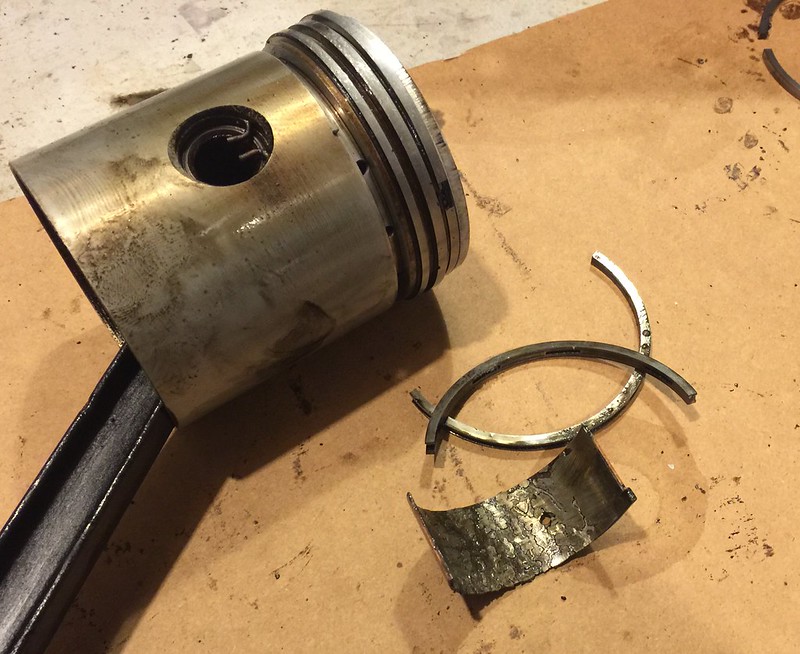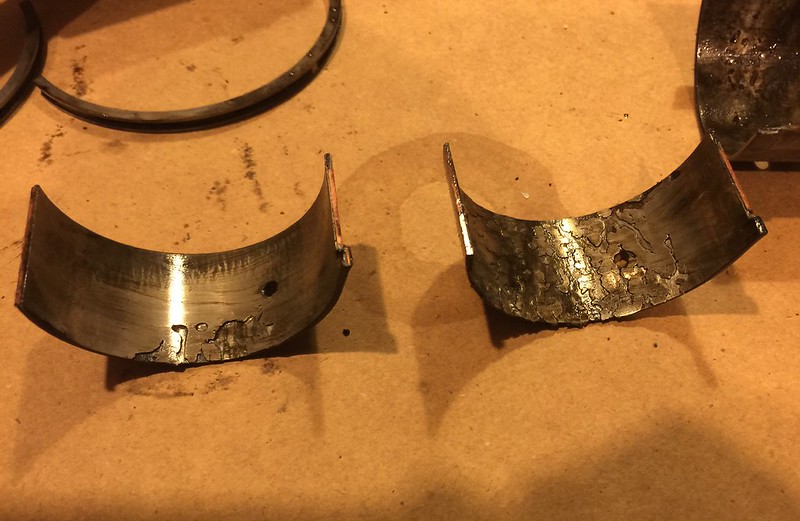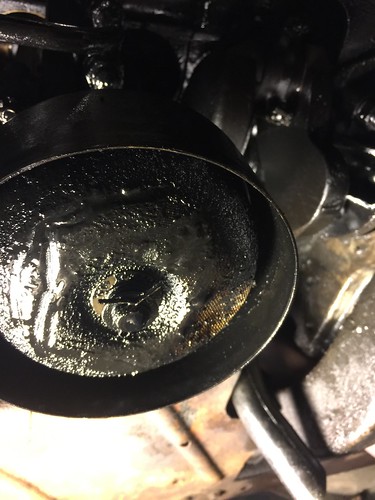
hchris
-
Posts
899 -
Joined
-
Last visited
Content Type
Forums
Gallery
Events
Posts posted by hchris
-
-
On 1/08/2016 at 0:43 PM, blakew said:
Pistons #3 and #4 out. Ridge reamer worked wonders. The ridge wasn't too bad, but it would have probably caused issues with the pistons coming out for sure.
Broken oil (bottom) rings on both pistons, but all others seem to be intact. #4 gave me the worst compression out of the lot, but visually, there wasn't much difference between #3 and #4.
Top side of bearing for #3 rod was a little rough, but top side of bearing for #4 was super bad.
About time to clean the oil screen too, I'd say.
Pictures below.



What I`m seeing from your photos doesn't look like a 67k engine, I would hazard a guess that this engine has had some work done on it not so many miles ago. Given that you have broken rings there would obviously be oil burning, and the piston tops are a good indicator of this; I suspect also that the valve guides would be contributing to the oil burning.
Getting the rings gapped and with proper side clearance is critical, probably wasn't done last time hence the broken rings. As much as I admire your enthusiasm you really should be seeking expert help here, particularly given the state of those bearing shells, have you had a close look at the crank pin surfaces ? they should be mirror smooth without any grooves or scratches, if you can feel any roughness with your finger nail then the crank shaft will need machining.
Probably none of this is what you want to hear, but if you aren't meticulous about it then you will just be throwing good money after bad.
-
Have you tried any of the Chrysler Restorers members in NSW ?
-
On 1/08/2016 at 9:00 AM, mrcvs said:
Fan belt is somewhat loose. But if I tighten it more, past experiences suggest it will just ride off the pulleys.
I assume you are aware that there is no water pump on the Maxwell, water circulation through the radiator is entirely dependent on the thermo syphon principle. With this in mind you cant afford to have any restriction or blockages in the cooling system, my first reaction would be to give the radiator a good flush out and see if things improve.
-
Watching the valves is a good indicator, given the firing order is 1,5,3,6,2,4 when #1 is at TDC both valves will be closed and the valves at #6 will be rocking, ie, inlet will be opening and exhaust closing.
Using this method eliminates all the possibilities of timing marks etc. being out, and will certainly be close enough to get the distributor in the right position, with rotor arm pointing to #1 spark lead.
-
 1
1
-
-
If you were to search "vapour lock" on this forum, there would be enough material to read until Christmas.
Essentially you need to consider 3 primary factors; (1) reduce the heat around the fuel lines, pump and carb. (2) use a premium grade fuel.
(3) make sure the pump is delivering the correct pressure output.
So the key elements in any fuel vapour issues are fluid temp, pressure and volatility (or Octane rating), tackle any or all of these and you will reduce the problem; you might never eliminate it.
-
3 hours ago, DavidMc said:
How does it work? How is a vacuum generated by the oil pump? Just curious.
The vacuum is created by the oil pump gears, obviously they create enough suction to lift the oil from the sump to the oil pump, there is a
restrictor which taps into that vacuum source at the oil pump and hooks up to the vac tank, so the same vacuum force is then used to create a low pressure area within the vac tank. With a low pressure area in the vac tank being applied to the fuel tank, fuel is drawn into the vac tank and fills up a reservoir, and at a certain level, a float mechanism and valves shut off the vacuum, once the reservoir level drops the same cycle begins again.
To amplify the previous post, this oil pump generated vacuum has an advantage open the more traditional manifold vacuum, as throttle opening variations affect the vacuum strength; for example if you are labouring up a long hill with throttle wide open the vacuum source diminishes, (ask anyone who as ever had vacuum sourced windscreen wipers), so with diminished vacuum your fuel supply to the vac tank is severely hampered and if the hill is steep enough you finish up spluttering to a halt.
The oil pump vacuum source doesn't suffer this problem, so long as oil is being sucked through the pump you will have a constant, relatively
stable vacuum source not much affected by engine load. The down side to this mechanism though, is that if the vacuum float shutoff mechanism at the top of the vac tank doesn't shut off, you will be sucking fuel straight into the oil pump, followed shortly after with an engine stoppage which will probably be rather expensive.
-
The Maxwell vacuum source is from the oil pump, not the intake manifold like most other makes. The line from the oil pump to that block fitting on top of the tank should only be about 1/8" dia.
Then, there should be a 1/4" pipe which also connects to the upper tank block fitting, this comes from the fuel tank. At the bottom of the vac tank, a line with shutoff tap should run to the carb.
Ok, just looked a little closer at photo 2; that thin copper line at the lower right of the oil pump needs to be connected to the right hand side of the block fitting at the top of the vac tank, from what I see of your photos you don't have a vacuum source connected to the vac tank, and yes the oil pump is the source of vacuum for this installation.
-
2 hours ago, robert b said:
It is possible that you have broken bendix spring , it is behind the small gear on the starter bob
If the engine turns over freely with the crank handle and the starter motor spins when you activate the starter, then its highly likely that the internal Bendix spring has broken.
Sourcing a replacement spring will be difficult, you need a vintage supply specialist to source one; any good auto electrician should be able to install it for you.
Having said that, an on line search for vintage starter repairs should unearth a fix for you.
-
7 hours ago, gundog99 said:
I was talking to a farmer today, Who has just opened an underground petrol storage tank, that has been sealed for about 30 years. Is the petrol still usable ?
I would definitely be doing a water contamination check before I put it in anything

-
A sheet of flat thick glass, such as in your side windows, gives a nice flat surface on which you can lay a sheet of fine grade wet and dry abrasive paper, or grinding paste.
Put the scored surface of the oil pump plate on the abrasive surface and move it firmly in figure 8 movements, to wear down the grooves, to the point that the surface of the plate is nice and smooth, wipe the plate surface regularly to remove any residue. Make sure all the pump surfaces are nice and clean prior to re installing.
Clearances within the pump are critical if you want to maintain good oil pressure, as mentioned .005" clearance would be the maximum
acceptable between gear and wall of the pump, .003" between the gear teeth and .005" between the end plate and gears; given that you have what I would consider excessive wear on the end plate, you probably need to go through the whole of the pump or perhaps find an acceptable
replacement.
-
So, the way the ammeter behaves it would seem the generator is doing exactly what it should be doing, that is cutting in and cutting out as the electrical load varies with the running of the car.
Whilst there is every possibility that the battery is a dud, any competent auto electrician should be able to put a load tester on it to prove that one way or the other.
Something else you could try before you lash out and spend unnecessary monies is to completely disconnect the battery from the car, fully charge it, then leave it overnight and see what charge remains next morning; if its still fully charged this would indicate that you have a circuit leak some where in the car wiring, and that is another story
altogether.
-
I`m with ply33, if its not knocking, has good oil pressure, not overheating nor blowing vast amounts of smoke and oil consumption not excessive, I would certainly keep driving if you don't intend to put too much strain on it.
Back in the day these engines were usually good for 60 - 70k miles, usually with a valve grind around 30k.
-
In all of this I don't see any remarks about how the ammeter is reading whilst you are driving; this should give you a clue as to the generator output, where is the needle when you have the engine running at driving speeds ? what does the needle do when you turn the lights on and off ?
As others have said you can adjust the output to cope with various electrical loads, but the key factor is to watch the ammeter response which tells whether the generator is functioning correctly.
-
Silicone bead has worked for me over many years on a number of different vehicles.
-
Most often when the car moves in neutral its due to mis rigging of the throttle / kickdown linkage. Most genuine service manuals will give you the details on how to adjust the linkages.
-
Another thought is that someone may have put in an additive with the trans oil, they will often change the oil color.
To check if its water, leave it in a clear jar for a day or so and the water will separate, naturally the water will sink to the bottom.
-
Although its not an exact exercise, if you just multiply atmospheric pressure (nominally 14.7psi @ sea level) by the known compression ratio, in your case 4.9, then you will have a ball park figure to work by.
-
I`m curious, I thought the 34 block still had the half water jacket ?
-
If the tank is original and unmolested it will have a sintered bronze (I think) filter at the pickup point inside the tank, if this is blocked (sounds highly likely) then sadly the only option is to open up the tank to get access to it.
-
Cant comment on the gooey stuff, but with regard to pulling to the left, have you checked that the right hand flex hose is in good order ?
Whilst it may appear ok on the outside, you need to consider that if it fails on the inside then fluid transfer to the right wheel cylinder could be restricted, thus lessening the braking effect for that wheel.
-
6 hours ago, 13CADDY said:
i've got 2 to 3 loose ones in each wheel-car drives ok,but i heard them klicking--any help would be appreciated--
First up I would agree with the previous answers, having said that it might be easier said than done depending on your locality.
The old school way was to hose them down and get the wood to expand, a short term solution.
If you have a bit of wood working expertise, an old timers trick was to drill down the end of the loose spokes and force in an appropriate size wooden dowel in order to expand the spoke ends, or perhaps you could find a savvy wood worker to try this one.
-
On 31/03/2016 at 0:18 AM, 1941_Saratoga said:
I'm trying to figure out an annoying little problem that's been occurring with my '41 Saratoga over the past several months, and would love some input...
About half the time I try to start the car, I get nothing but clicking from the starter. Immediately I thought solenoid, but I had just had the starter and solenoid rebuilt less than 2 years ago. I've checked all the wiring with a meter (all good), and then used a set of jumper cables to bypass everything, first checking the solenoid (intermittent), then bypassing the solenoid to see if the starter would spin (intermittent).
I took the starter off, opened up the solenoid, and everything looks pristine - all contacts, point, plunger moves freely. I'm wondering if one of the brushes in the starter is a little dirty. Anyway, I reinstalled the starter, with the same results, and noticed that if I turn the ignition key to accessory mode, then press the starter button, the car cranks. If I immediately turn the key to the right, the car cranks and starts. This works 100% of the time.
So a few questions come to mind (and forgive my ignorance!)...
(1) Should the engine turn over when the key is in accessory mode?
(2) Is there any damage I might do by starting it this way?
(3) Is there something I might be overlooking before I pull the starter again and send it back to the rebuilder?
Appreciate any suggestions you might have! Thanks!
Dave
In part answer, I think you will find the starter will turn even if you don't have the key in the ignition switch, the starter Solenoid circuit is normally direct wired to the battery and the ignition switch actually serves to connect the ignition circuit whilst the starter is cranking.
The fact that you are able to go from accessory position to the run position and have the engine fire up sounds like a previous suggestion that the ignition switch is at fault.
-
A result like this just reinforces the value of a site like this.
Well done folks

-
My car was built before they started using the water distribution tube, but I believe the holes in the tube face up as they are intended to direct coolant flow to the underside of the valve seat areas.
Correct



Stewart Vacuum Tank
in Technical
Posted
Cant say what other makes had the oil pump vac feed, but my Maxwell was fitted with one, and in my experience, was much more reliable than the manifold vac fed units.
The oil pump sourced vacuum is constant at all engine speeds, unlike manifold vacuum which varies with engine load and throttle position. The down side of manifold vacuum sources are when going up hill, if the hill is steep enough eventually the vacuum drops to a point where it cant pull the fuel from the tank and you splutter to a halt; no such problem with the oil pump vac.
Another consideration is, that if the oil pressure were to drop, then the vac source is lost followed by a lack of fuel, and you could save the
engine before the bearings quit from lack of lubrication.